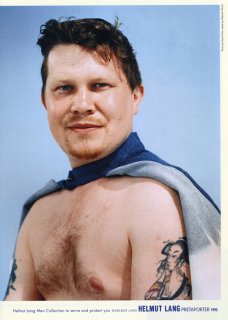The Label: Cool, intellectual, and occasionally transgressive, Helmut Lang defined luxe minimalism in the nineties (along with Jil Sander, Prada, and Calvin Klein). Like Klein, Lang focused on sharply cut suits and trousers, with references to the kinkier side of fashion via bondage pants or leather harnesses worn over T-shirts. His suits, and later his phenomenally popular jeans, became a uniform for power brokers in creative industries like film, art, advertising, and fashion.
The Look: For the reed-thin type-A personality; austere lines, dark colors, beautiful materials (often mixed in unexpected but never garish ways, like stretch elastic with fine wool) and strict tailoring.
The Designer: Born in Vienna, Austria, in 1956, Lang originally studied business but started designing clothes in the late seventies. In 1986 he began to show his women’s line in Paris, followed by men’s collection a year later. Against the excess of the late eighties, Lang’s stripped-down fluidity (no shoulder pads, no linings, straight lines, no embellishment) looked intelligent and serious, while the narrow cut flattered customers who’d been meeting their personal trainers three times a week. His look was also easy to knock off, which made it especially popular with chain retailers like Club Monaco, Zara, and Banana Republic, who sold millions of black jackets, V-neck sweaters, and slim dark trousers on his watch.
Although his persona seemed to give priority to higher thinking—his friends came more from the worlds of art, architecture, and photography than the social worlds of fashion—he was extremely savvy about business. His denim line, introduced in spring 1997, showed that his customers were willing to pay over $100 for a pair of jeans, and revived the market for dark, stiff denim. Technologically more adventurous than many of his counterparts, Lang was one of the first to make his runway presentation instantly available online, and at one point he was so influential that his decision to show his collection in New York before the Paris and Milan shows permanently altered the runway fashion calendar.
Lang moved to New York in 1998 and began showing his line here, although his lines were manufactured in Italy. He sold his business to the Prada Group in 1999, during the mergers and consolidations fever that swept the industry in those years. It wasn’t a successful marriage, though, because the business didn’t grow fast enough to satisfy its parent company, and Lang left in spring 2005. Prada then sold the name to the American company Link (owners of Theory), which placed former Habitual designers Michael and Nicole Colovos in charge of the brand. Their debut line is scheduled for spring 2007. Lang himself, meanwhile, spends much of his time at his East Hampton house and occasionally hints at new projects but, as of early 2007, had not revealed his plans.










 precious! thanks mma!
precious! thanks mma! 
 wow, this was truly a long overdue, thanks for starting it, MissMag!.
wow, this was truly a long overdue, thanks for starting it, MissMag!. 









 the kirsten owen one is fabulous
the kirsten owen one is fabulous















